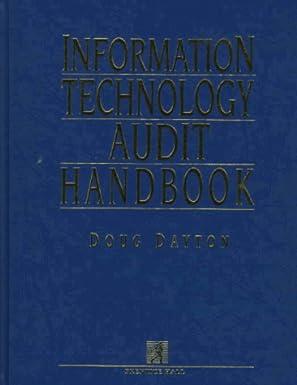Question
10. Auditors perform a reasonableness test comparing their estimate to the amount shown in the trial balance. What type of evidence is this? a. Analytical
10. Auditors perform a reasonableness test comparing their
estimate to the amount shown in the trial balance. What type
of evidence is this?
a. Analytical review
b. Confirmation
c. Reperformance
d. Inspection of documents
e. None of the above
Answer ____
11. The accounting clerk steals a customers check meant to pay
their account balance. To remove the accounts receivable
from the accounting records, the clerk writes off
[debit allowance for doubtful accounts, credit accounts
receivable] the customers account. This scheme is likely to
be discovered because:
a. The customer will demand repayment.
b. The customer will be told that it will be necessary to
pay cash for purchases in the future since their account
had been written off in the past.
c. The clerk will forget which account was written off.
Answer ____
12. Testing sales for completeness (i.e. UNDERstatement),
an auditor selects 50 sales invoices and vouches them to
the respective shipping documents. This evidence is not
appropriate because of the violation of:
a. Auditor's direct knowledge.
b. Objectivity
c. Reliability
d. Relevance
Answer ___
13. Auditors sometimes use ratios as audit evidence. For example
an unexplained INCREASE in the ratio of gross profit
to sales may suggest which of the following possibilities?
a. Fictitious purchases. b. Unrecorded purchases.
c. Unrecorded sales. d. Selling expense recorded as general expense.
Answer ____
14. In discussing audit procedures for contingent liabilities, we
discussed the analysis of legal expense. Say the auditor
asks the controller for the file containing attorney invoices
[i.e. bills from lawyers]. In reviewing the invoices, the
auditor notes that they sum to [total] $1,000,000, while the
amount shown in the general ledger account for legal expense
totaled $1,500,000. In this context, what did we suggest as
the auditors chief concern?
a. Too much is being spent on attorney fees.
b. There is likely a misclassification of an expense.
c. The auditor did not receive all the attorney invoices.
d. Legal expense is overstated.
Step by Step Solution
There are 3 Steps involved in it
Step: 1

Get Instant Access to Expert-Tailored Solutions
See step-by-step solutions with expert insights and AI powered tools for academic success
Step: 2

Step: 3

Ace Your Homework with AI
Get the answers you need in no time with our AI-driven, step-by-step assistance
Get Started


